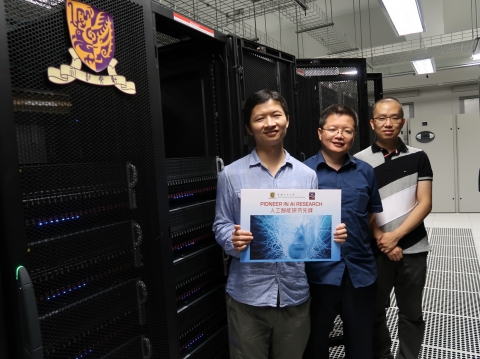The Chinese University of Hong Kong is one of the pioneers in the research on Artificial Intelligence (AI) and Deep Learning. The CUVideo team from the Department of Electronic Engineering has recently shone in the ‘ImageNet Large Scale Visual Recognition Challenge’ (ILSVRC), one of the most important grand challenges in Computer Vision. Moreover, In the GPU Technology Conference 2016 held in Silicon Valley, CUHK Multimedia Laboratory was named as one of the pioneers in AI research. CUHK was the only institution in Asia to receive this recognition, alongside the University of California, Berkeley, Massachusetts Institute of Technology, Stanford University and the University of Oxford. Moreover, the research teams from Department of Information Engineering, Department of Electronic Engineering, Department of Systems Engineering and Engineering Management, as well as the Department of Computer Science and Engineering at CUHK are committed to developing a wide variety of Deep Learning and AI applications. The Department of Electronic Engineering will also introduce a new elective course on Deep Learning for undergraduate and postgraduate students in the academic year 2016-17. Outstanding Achievement in the Grand Challenge of Computer Vision Led by Prof. Ouyang Wanli, Prof. Li Hongsheng and Prof. Wang Xiaogang of the Department of Electronic Engineering, the CUVideo team has participated in the ‘ImageNet Large Scale Visual Recognition Challenge’ (ILSVRC) which was the most influential challenge in the field of Computer Vision. There were four categories in the challenge; objection detection, object localization, object detection from video, and scene classification. CUVideo team achieved the best result in the challenge of object detection in videos with provided data, which required each team to detect 30 object categories from 1,000 videos. CUVideo team achieved the mean Averaged Precision (mAP) of 67.8% and also won 28 object categories among 30. Pioneer in AI Research CUHK Multimedia Laboratory was established by Prof. Tang Xiao of the Department of Information Engineering in 2001. It was the first research team who applied Deep Learning to Computer Vision in Hong Kong. In the GPU Technology Conference 2016, hosted by NVIDIA in Silicon Valley, CUHK Multimedia Laboratory was named as one of the pioneers in AI research, alongside the laboratories of the University of California, Berkeley, Massachusetts Institute of Technology, Stanford University, the University of Oxford and other top laboratories. NVIDIA is the inventor of the GPU**.The GPU Technology Conference has gathered top researchers and professionals in the field. CUHK will have priority pre-release access to hardware and software provided by NVIDIA with an aim of advancing the research facilities and technical support for various Computer Vision related applications including video surveillance, web scale image and video search, as well as human and computer interaction, thereby promoting the development of Deep Learning and Computer Vision. The team has built a novel facial recognition system that achieved the world’s highest accuracy of 99.15% in 2014*. Its accuracy outperformed human eyes in human face verification performance. Their work with Microsoft Research Asia is now being used by two major Microsoft products: Intentsearch being used in the Bing search engine for similar image search, and Digital Effect being used in MSN webcam. Deep Learning’s Development and Nurturing Talents on Deep Learning Deep Learning is one of the breakthroughs of AI research. It simulates the human brain's behaviors by training large scale neural networks from big data based on intensive GPU computing. CUHK is a pioneer in the research on Deep Learning. The research team led by Prof. Tang Xiaoou and Prof. Wang Xiaogang, developed a novel facial recognition system as early as 2011. It can be applied to security, law enforcement, internet and entertainment. Different research teams are also dedicated to the application of Deep Learning in various areas. Prof. Meng Mei-ling, Helen of the Department of Systems Engineering and Engineering Management and Prof. Lee Tan of the Department of Electronic Engineering have applied Deep Learning in Speech Recognition and Text-to-speech Technology. In the Department of Computer Science and Engineering, Prof. Heng Pheng-ann has applied Deep Learning in Medical Imaging and Prof. Jia Jiaya, Leo has applied Deep Learning in Computer Vision. The Department of Electronic Engineering at CUHK will also introduce the territory’s first elective course on Deep Learning for undergraduate and postgraduate engineering students in the academic year 2016-17. The course will cover the theories, models, algorithms and applications on Deep Learning. CUHK Multimedia Laboratory CUHK Multimedia Laboratory was established in 2001. It was the first research team to apply Deep Learning to Computer Vision. In 2009, the laboratory won the Best Paper Award at the IEEE Conference on Computer Vision and Pattern Recognition (CVPR). It is the first and only research institute in Asia to receive this top honour since the establishment of the conference 30 years ago. Members of the laboratory also won various paper awards. The laboratory has trained many experts in AI. Some students pursued further studies in Massachusetts Institute of Technology, Stanford University, the University of Cambridge, Columbia University and other internationally renowned universities. The laboratory has been selected as Hong Kong’s first NIVDA CUDA (Compute Unified Device Architecture) Research Centre. For more information about CUHK Multimedia Laboratory, please visit http://mmlab.ie.cuhk.edu.hk/index.html * It was tested by the ‘Labeled Faces in the Wild’, which was a database of face photographs and contained thousands of picture sets, regardless of changes in lighting, make-up and camera angles. ** Graphics Processing Unit (GPU) is a high-performance processor that generates breathtaking and interactive graphics on game consoles, personal computers and mobile devices. |
|



